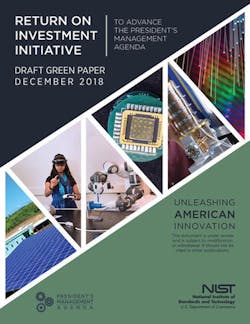NIST Unveils Plans to Modernize Tech Transfer From National Labs
The U.S. spends more than any other nation on R&D each year, investing more than $150 billion in federally funded R&D alone. In line with President Donald J. Trump’s Management Agenda, the Dept. of Commerce’s National Institute of Standards and Technology (NIST) released a paper, “Return on Investment Initiative,” that details steps to modernize technology transfer and innovation for the 21st Century. Actions outlined in paper would improve the returns on the taxpayer investment in R&D.
“Countless innovations crucial to our everyday lives, including life-saving vaccines, the internet and GPS, trace their roots to federal labs and federally funded R&D,” says Secretary of Commerce Wilbur Ross. “The steps outlined in this new report are strong proposals to pave the way for the competition-driven technological advances that are the cornerstone of American success.”
“Implementing these actions would increase the impact of federal R&D investment through agile partnerships that can create tremendous value for our society and economy,” adds Under Secretary of Commerce for Standards and Technology and NIST Director Walter G. Copan. “For example, granting reliable and predictable intellectual property rights for licensing and commercial development of federal research will also encourage innovation and more private sector investment in R&D.”
Much of the legal architecture around technology transfer is based on two transformational pieces of legislation from the 1980s: the Stevenson-Wydler Technology Innovation Act and the Bayh-Dole Act. These Acts provide more clearly define intellectual property ownership and encourage commercial development of federal R&D.
To ensure America stays on the cutting edge of technological development, the paper lays out actions aligned with five strategies outlined in the Lab-To-Market Cross Agency Priority (CAP) Goal of the President’s Management Agenda: 1) identify regulatory impediments and administrative improvements; 2) increase engagement with private sector experts and investors; 3) build a more entrepreneurial R&D workforce; 4) support innovative tools and services for technology transfer; and 5) improve the understanding of global science and technology. Those actions include:
Reducing regulatory and administrative burdens. The paper outlines changes that would “make it easier for industry to work with Federal Laboratories and access federally funded R&D.” It highlights the importance of defining the scope of the “government use license” and “march-in rights,” which let the federal government use an invention for broadly defined purposes and grant additional licenses if the original nonfederal inventor or licensee fails to develop the invention for public benefit, respectively. It also outlines steps to clarify requirements for domestically manufacturing products stemming from federal R&D.
Increasing private sector engagement. There are actions that need to be made so that the technology transfer process is easier to navigate. That includes promoting best practices and establishing government-wide consistency in interpreting legislation. To attract private investment and speed technology transfer, the government should authorize new and expanded mechanisms for creating partnership agreements and nonprofit foundations that support federal agencies. There’s also a proposal to use some R&D funding to protect intellectual property.
Entrepreneurship in R&D. The paper proposes establishing technology entrepreneurship programs at federal R&D agencies to foster entrepreneurship inside the federal government. There’s also a need to clarify and update conflict-of-interest requirements to encourage more partnering between the private sector and researchers at federal labs and federally funded universities.
New tech transfer tools. The U.S. should develop a modern, easy-to-use federal intellectual property reporting system to more effectively track IP and streamline regulations. Hand-in-hand with this effort, a new data portal could provide the public with easy access to IP and other R&D assets, enabling greater private sector awareness of federally funded knowledge, capabilities, and facilities.
Measuring effectiveness. Ensuring the best ROI for federal research funds requires better metrics on the outcomes and impacts from R&D investments. To that end, the government needs an “authoritative analysis…of metrics for federally funded R&D that can be used to capture, assess, and improve R&D outcomes.”
The paper is available on the NIST website. Comments will be accepted via e-mail if received by Jan. 9, 2019.


